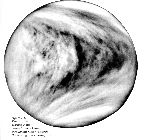

There was the Door to which I found no Key;
There was the Veil through which I might not see.
-- Omar Khayyam
Exploration is the essence of the human spirit. The truth of this statement has been evident for as long as humans have inhabited Earth. For those whose curiosity extends to the other members of our solar family, another truth has been evident: our human spirit has been frustrated by Venus, our nearest planetary neighbor. For the last few centuries, dark clear nights and chilly morning hours have found us straining our eyes in the direction of this planet next door.
Just looking has taught us a lot. We have become aware of Venus' orbital motions around the Sun, its phases that are similar to those of the Moon, and the fact that Venus is the most like Earth in size, mass, and distance from the Sun. But the root of our frustration is the atmosphere of thick swirling clouds that perpetually hides the Venusian surface from view (see Figure 1-1).
However, a significant discovery was made in the 1940s that would eventually revive our sagging spirit: some radar waves are unaffected by clouds, yet are reflected by solid surfaces. By the early 1960s, radar-system facilities at Goldstone, California (Jet Propulsion Laboratory), Haystack, Massachusetts (Massachusetts Institute of Technology), and Arecibo, Puerto Rico (Cornell University), were, for the first time, able to identify persistent features in the radar data reflected from Venus. With the help of computer processing, crude images of the Venusian surface were produced. From these early studies, radar scientists computed the rotation rate of the planet, which is equal to 243 Earth days. They learned that this rate is much slower than that of the clouds, which the Mariner 10 mission in 1974 determined to be approximately 5 days. Another discovery revealed that Venus rotates in a retrograde direction, a direction opposite that of most of the other planets in the solar system. These radar studies also helped to refine our estimate of the distance between Earth and Venus and thus the astronomical unit (the average distance of the Earth from the Sun -- about 150 million kilometers or 93 million miles).
Earth-based radar imaging is still a valuable tool in our continuing exploration of Venus. But it is also very limited. Venus always shows the same hemisphere to us when its orbit brings it near enough for the best observation, so only a fraction of the planet can be explored from Earth.
The early 1960s also brought about the use of spacecraft to explore Venus and, since that time, Venus has been one of the most visited planets in the solar system (see Table 1-1). Fifteen Soviet and five U.S. spacecraft have probed its sulfur-yellow clouds to measure atmospheric structure and composition. Other investigations disclosed a lack of water vapor and the absence of a magnetic field. Seven of the Soviet craft were landers that conducted chemical analyses of rocks, which indicated that some rocks were of volcanic origin. One of the landers, Venera 9, gave us our first glimpse of the surface when, in 1975, it relayed a panoramic view of the Venusian landscape (see Figure 1-2).
These discoveries were enhanced by observations in the field of radio astronomy, which indicated that Venus is a perpetual furnace, where surface temperatures reach 482 degrees centigrade (900 degrees Fahrenheit) and the atmospheric pressure is 90 times that of Earth.
The 1978 U.S. Pioneer Venus Orbiter (PVO) was the first spacecraft to carry a radar sensor to our sister planet. Ninety-two percent of the surface was mapped with a resolution (a measure of the smallest objects that can be seen in the resulting images) of 50 to 140 kilometers (31 to 87 miles). For the first time, planetary scientists had a global map of Venus. The existence of continentlike highlands, hilly plains, large volcanolike mountains, and flat lowlands was revealed.
Five years later, the Soviet Venera 15 and 16 spacecraft used radar to map about 25 percent of the northern polar region at a resolution of 1.2 to 2.4 kilometers (0.7 to 1 mile). These images revealed evidence of abundant volcanism, impact craters, complex tectonic deformation, as well as coronae -- unusual, large, ovoidal features of apparent volcanic-tectonic origin (see Figure 1-3).
Yet, for all our accumulated knowledge about the atmosphere and the large-scale surface features, we know very little about the hills and valleys, craters, and lava flows -- the telling details of Venusian geology. We wonder about the extent to which Venus' surface has been shaped by volcanoes, plate tectonics, impact craters, and water and wind erosion. Are the processes that produced the Venusian surface features still active?
The Magellan radar imaging spacecraft was launched from the Space Shuttle Atlantis on May 4, 1989, in search of the answers to these important questions. The spacecraft will maneuver into orbit around Venus on August 10, 1990 (see Figure 1-4). For the next 243 days (one Venus rotation), Magellan will gather radar imaging, altimetry, and radiometry data as it orbits the planet every 3.15 hours. Seventy to 90 percent of the Venusian surface will be mapped at resolutions that vary from 250 to 600 meters (800 to 2,000 feet), a view nearly 10 times better than that of any previous spacecraft. While Magellan sends data to Earth during each orbit, ground personnel will precisely measure slight changes in the spacecraft's orbital motion caused by variations in Venus' gravitational field. These measurements will provide important clues about the nature of the planet's interior.
Magellan's innovative method of radar mapping, called synthetic-aperture radar (SAR), is key to fulfilling our long-awaited desire to unveil the secrets of our closest and most mysterious planetary neighbor.
 Chapter 2 - The Magellan Mission
Chapter 2 - The Magellan Mission
![]() The Magellan Venus Explorer's Guide
The Magellan Venus Explorer's Guide

